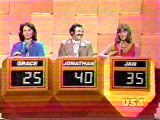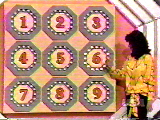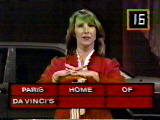Sale of the Century
From RulesWiki
| SALE OF THE CENTURY | |
| The opening title from the 1980s Sale of the Century. | |
|---|---|
| Airdates: | NBC September 1969 - July 1973, Syn. September 1973 - September 1974; NBC January 1983 - March 1989; Syn. January 1985 - September 1986, Syn. September 2007 - Present ("Temptation: The All-New Sale of the Century") |
| Hosts: | Jack Kelly, Joe Garagiola, Jim Perry, Rossi Morreale |
| Hostesses: | Barbara Lyon, Kit Dougherty, Sally Julian, Lee Menning, Summer Bartholomew |
| Announcers: | Bill Wendell, Jay Stewart, Don Morrow, Rolonda Watts |
| Producers: | Jones-Howard Productions (1969-1974), Reg Grundy Productions (1983-1989), Fremantle Productions (2007-2008) |
Contents |
Gameplay
1969-1974 version
Three contestants (this changed to two married couples in 1972) competed, each starting with $20 cash. A series of general knowledge questions were asked, and only the first player to jump in got to answer each one. A correct answer added $5 to a player's score but an incorrect answer deducted $5. As the game progressed the value of the questions increased to +/- $10, and later +/- $15. When the show changed to its two couples format, one round of $5 questions was played, followed by a round of $10 questions, and the game ended with five $20 questions. At various points during the game, an "Instant Bargain," a prize offered at an incredibly low price would be offered to the contestants, and the first player or couple to buzz in would have the bargain price deducted from their total, but could keep the prize regardless of the outcome. The player or couple with the highest cash total at the end of the game was given the chance to shop for one of the grand prizes available at the Sale of the Century. Winners could choose to buy a grand prize with their winnings and retire or hold out for more and larger prizes, since they were allowed to purchase more than one grand prize, or even all the prizes on stage if they could afford it.
1983-1989 version
Front Game
Three players competed, each starting with a $20 stake. The host asked a fairly easy general knowledge question. Players may buzz whenever they like, but an early buzz may mean that the player will have to answer without hearing a crucial bit of information. If right, $5 was added to their score; otherwise, $5 was deducted and the two opponents did not get to answer.Three Instant Bargains were held during the game, but only offered to the player in the lead. In the case of a tie, whoever pressed their buzzer first bought the item, though sometimes Perry would auction the item off, decreasing the price or adding cash. Starting in 1984, some Instant Bargains included a cash bonus that would not be revealed until after the player had decided whether or not to buy. In 1986, the third Instant Bargain was changed to "Instant Cash," where the player in the lead was offered a one-in-three chance at a growing cash jackpot (which started at $1000 and increased by $1000 every day until it was won, the other two chances were each worth $100), in exchange for their lead over the second place player.
Alternating with the Instant Bargains were "Fame Game" questions. Perry would ask a long question describing a person, place, or thing. Players could buzz in at any time while the question was read. A wrong answer eliminates a contestant for the rest of the question, with no loss of money. A right answer gave the contestant his choice of nine different panels on the Fame Game board. The Fame Game board hid cash amounts, prizes, but contestants generally were hoping for "money cards," which would add to their game score. Originally, players would choose a portrait from the gallery, that was changed to a number from 1-9, then stopping a bouncing light to pick a number.After the third Fame Game, Perry would ask three more questions. Whoever had the most money after the three questions won. By early 1984, this was changed to a 60-second "speed round" of rapid-fire questions.
Shopping End Game (1983-1984, 1985)
The winner from the front game was then shown a series of more luxurious prizes offered at a discount price. The first prize, worth around $3,000 was offered at roughly $75-$85. The contestant was always offered the first level prize, no matter what their score was. The contestant was then given a choice: buy the most expensive prize the bank account allowed, or pass on it and save their earnings to amass more for larger prizes. Getting to $430 won a luxury car. Champions who stayed on long enough to collect $500 won all of the prizes on stage along with extra cash to total an even $95,000.
By mid-to-late 1983, the luxury car was offered for $540; $650 would win an escalating cash jackpot (worth $50,000 plus $1,000 for each day not won), and $760 won all of the prizes and the cash jackpot. When the syndicated version debuted in 1985, $530 won the car, $640 won all of the prizes on stage (worth over $60,000), and $750 won all the prizes and the cash jackpot.
Winner's Board (1984-1987)
In November 1984 (and in December 1985 on the syndicated version) the bonus round changed to the "winner's board." The winner picked numbers from a board of 20 panels. The board had ten prizes available to win: seven prizes worth between $2,000 and $10,000 in value, $3,000 in cash, and two "jackpot" prizes; $10,000 in cash, and a luxury car. The minor prizes had two cards on the board; the car and $10,000 had only one. Two remaining panels hid "win" cards; after uncovering that card, the player would win the next prize revealed.
As each prize was won, those spaces were taken off of the board. After winning ten days and all ten prizes, the champion was then given a decision to make: take all the prizes won (over $50,000), or risk all ten prizes to play one more game. Winning the next game won the champion an additional $50,000. A loss forfeited all of the prizes won from the winner's board (anything won in the main game was still theirs to keep.)
Winner's Big Money Game (1987-1989)
In December 1987, the bonus game changed again. The winner of the day was awarded a prize for winning the main game. Then the contestant selected from three envelopes (colored red, yellow and blue). Each packet contained a series of puzzles consisting of a six-word sentence that pertained to a person, place or thing. Each word was revealed one word at a time until the contestant hit a plunger that stopped the clock. The contestant's goal was to solve 4 puzzles in 20 seconds (originally 5 in 25 seconds.) Running out of time or giving two incorrect answers resulted in a loss. Winning the bonus game on the first day won $5,000. Each return to the bonus game increased the potential prize by $1,000, up to $10,000 on the sixth day. The seventh bonus game had a sedan or other midsize car as the prize. Players who won the car got to play an eighth day, otherwise they retired at that point. An eighth victory gave the champion an opportunity to play one final bonus game for $50,000.2007-present version ("Temptation: The All-New Sale of the Century")
Front Game
The new version is based more on shopping and pop culture. Each player starts with 20 "Temptation Dollars". The game begins with a 30-second speed round. As in previous versions, questions are worth plus or minus $5. An Instant Bargain is then played, followed by a Fame Game worth a flat 15 Temptation Dollars. In this Fame Game, as the clues are given, the answer is revealed one letter at a time.
The players then play a game called Knock Off. A category is given with twelve possible answers, nine right and three wrong. In order from third place to first, players take turns choosing answers. A correct answer adds money (ranging from $2-$15) but a wrong answer takes a player out of the round. This continues until all incorrect answers or all correct answers have been found. A second Instant Bargain is then offered, followed by a 30-second speedround, where each clue pertains to one of two items. Then Instant Cash is played, same as the 1980s version, except that the jackpot starts at $500 and increases by the that amount up to $5000 until won.
One final 30-second speed round is played, with all answers worth +/- $10, with the winner going to "Shopper's Paradise."
Shopper's Paradise
Five prizes of various value, with the grand prize being a trip or a car offered for about $800-$900, are up for grabs. Before shopping, the player plays Super Knock Off, with six correct answers and six incorrect. Each correct answer is worth $25-$100 toward the player's account, for a total of $250. The player chooses answers until finding all correct answers, electing to stop, or finding an incorrect answer, at which point all Super Knock Off winnings for that round are lost. The player then decides whether or not to buy one of the five available prizes and retire, or to hold out for an even greater prize. In this version, players remain as champion until buying a prize, defeated, or reaching the five-game limit, at which point they must purchase a prize.
Notes
- The largest cash jackpot won on the show was $109,000 won by David Rogers in 1984.
- The highest main game score was $145, attained by Bill Fogel in 1984; beating the player in second by $100.
- The biggest winner on the show in terms of total winnings was Tim Holleran, who won a total of $166,875 (including a $90,000 jackpot) Tim later won $20,000 in cash and prizes during the 1987 International Invitational Tournament.
- The show held three "Tournament of Champions" events during its run, one in late 1983, another in early 1985, and one in 1988. An International Invitational Tournament between champions on the American version of the show was contested between champions on the Australian version of the show, and Canadian competitors in 1987. The eventual winner (who was awarded a $36,000 Chevy Corvette) was Cary Young, the Australian finalist who had already won over $300,000.
- During Instant Bargains, host Jim Perry would often announce the closing of the offer by saying, "Going once... Going twice... No Sale." For Temptation, a "Shop Clock" appears onscreen, counting down from 5 to indicate the expiration of the offer.
- The "Temptation" version featured a home shopping segment where before commercial breaks, the items awarded as prizes would be offered to viewers at a discount price.





